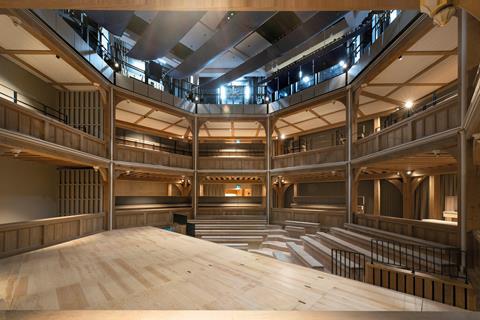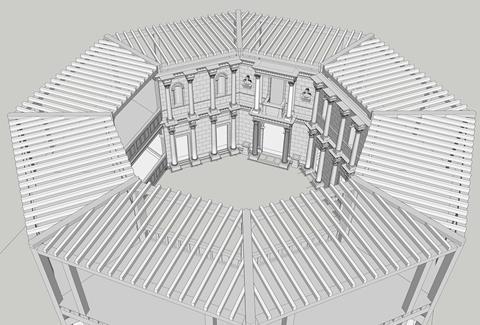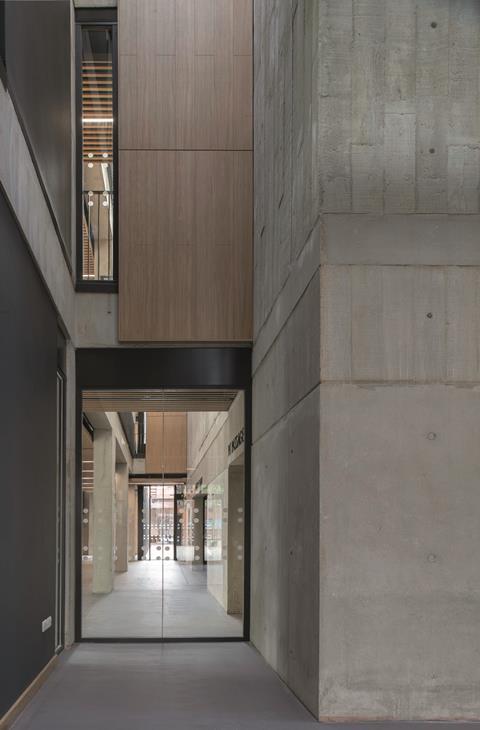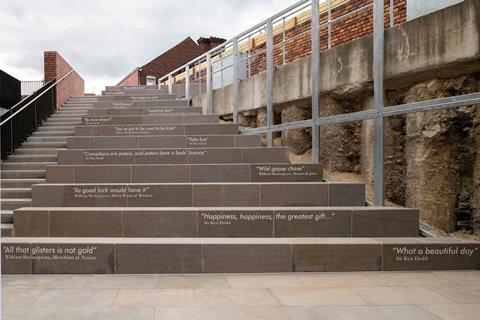From the outside it looks like a modern fortress but inside, Shakespeare North Playhouse, the brainchild of Knowsley council, is all Tudor come Jacobean drama – with just a touch of Ken Dodd, writes Thomas Lane

Like with fast railways, financial services and film studios, the North is missing out – this time on dedicated Shakespearean theatres. London has the Globe, a replica of an Elizabethan theatre, and the Sam Wanamaker Playhouse, which is a replica of a Jacobean one. The Midlands has Stratford-upon-Avon’s Royal Shakespeare Theatre, home of the Royal Shakespeare Company, with an auditorium that is a modern interpretation of a Shakespearian-era theatre.
Now the North is finally getting its very own Tudor replica to address this imbalance. Appropriately, it is called Shakespeare North Playhouse and has been built in a modest town called Prescot, 10 miles from Liverpool’s waterfront.
Why build such a significant theatre in a small town when, in true northern tradition, there is only one slow train an hour to Liverpool? The answer is a combination of historical precedent – there is evidence of a long-vanished Elizabethan theatre in Prescot – and an enterprising council that set about levelling up Prescot long before Boris Johnson politicised the term.
这个组合产生了一个独特的建筑,它的中心是一个传统的都铎-come- jacobean礼堂,由一个现代的“环绕”包围,包括门厅、酒吧、现代工作室空间和教育设施。从外观上看,这座建筑是现代的,没有任何历史中心的痕迹,不像它在南方的表亲,他们的历史起源都在他们的袖口上。

What also distinguishes this building from the Sam Wanamaker Playhouse and to some extent the Globe is that there was no evidence to suggest what the original Prescot theatre would have looked like. How does one go about building a replica of a historic theatre when no plans exist, and it has to double up as the saviour of a once prosperous industrial town?
The idea to build a Shakespearean theatre in Prescot germinated from conversations between Nicolas Helm, an architect specialising in theatres, and Richard Wilson, a Shakespearean academic. They established that the fifth and sixth earls of Derby, who lived at nearby Knowsley Hall, were patrons of Shakespeare and his fellow actors and owned some of his plays. They also discovered there had been a theatre in Prescot, creating a link between Shakespeare and the town.
>>> Also read:Projects: The Box, Plymouth
>>> Also read:St Hilda’s College revamp: serenity and unity down by the river
>>> Also read:Projects: Bloomsbury Theatre, London
没有任何计划的剧院设计是如何建立的?据了解,拟议中的剧院所在地曾是普雷斯科特斗鸡场的所在地。另一个偶然的联系是,位于伦敦白厅(Whitehall)的皇家驾驶舱剧院曾被德比伯爵(earl of Derby)的球员使用。
This cockpit was built in 1533 by Henry VIII and was occasionally used as a theatre. In 1629 Charles I commissioned architect Inigo Jones to design a permanent theatre on the site. This featured an end-on stage with a decorative frons scaenae, an architectural Roman backdrop at the back of the stage.
莎士比亚北剧院的设计使它可以被配置为三种方式:圆形剧院,像一个座舱,一个末端舞台和一个推力舞台。“我们最初设计的是宫廷的座舱,1629年的剧院,随着讨论的深入,我们发展了这个更广泛的概述,以拥抱这100年的历史,”建筑师Austin-Smith:Lord的总监迈克·耶茨解释说,他与Helm Architects密切合作设计。

How did the team get from this concept to a green oak-framed theatre arranged as a double octagon capable of seating 470 people? A common thread running through the Globe, the Sam Wanamaker Playhouse and the Shakespeare North Playhouse is Peter McCurdy, whose firm McCurdy & Co built all three auditoriums and, in the case of the Globe, the building frame, too.
他解释说,有皇家驾驶舱的记录。“我们从16世纪的伦敦地图和插图中知道它是一座八角形建筑,有一幅17世纪中叶的画作表明它是一座相当坚固、突出的建筑。”

Evidence of the changes made by Inigo Jones in 1629 came from historical drawings. “The evidence we have for the Inigo Jones conversion to a permanent theatre are drawings that were discovered in Worcester College Library in Oxford in the 1960s,” explains McCurdy.
有人从书架上取下一本书,设计图掉了出来。它们清楚地展示了建筑的多边形形式,它们给了我们建筑的大小,它们展示了正面场景的细节。”
The drawings for the Sam Wanamaker Playhouse came from the same Oxford library and were used to design that building, although McCurdy says the Jacobean detailing came from several other sources.
The auditorium
McCurdy解释说,莎士比亚北剧院礼堂的主要参考是伊利大教堂上的灯笼,因为这是非常相似的大小。这座建筑始建于14世纪,其特点是在八角形的每一点上都有8根近1米宽的巨大柱子。
麦科迪说,为了正确解释都铎式驾驶舱的结构,主要的柱子必须“相当坚固”,尽管不是1米宽。北莎士比亚剧场的柱子宽450毫米,因为它们必须被塑造成5到6个面。
The octagonal shape of the auditorium means the beams supporting the levels above join the posts at an angle, so more material needs to be removed on one side of the post. “We did have some pretty sizeable trees,” McCurdy says.
We had to find a crane that would fit into the space and work within the constraints of the structure that was already up
Peter McCurdy, McCurdy & Co
该剧院由Kier在一个前停车场上建造,从一边到另一边倾斜了3.5米。这就需要一个连续的桩墙来保留高地的地面。由于基岩靠近地表,该建筑位于筏形基础上。剧院的框架是就地混凝土,位于一个19米宽的方形盒子内,有24米高的墙。Kier集团的项目经理Andy Brayne解释说:“建造并不容易,因为在一楼有一个巨大的混凝土声学地板,这是剧院的基础,下面还有一个展览空间。”
The theatre box walls, which are visible from the foyers in the wrap-around area, were cast using heavily textured wooden boards which give these a characterful finish. A concrete mix consisting of 60% GGBS was used for these walls, which presented Kier with some challenges as such a high percentage of cement replacement slows down the concrete set and curing time for each lift. This meant pouring the concrete more slowly to give it time for the initial set, so it didn’t exert too much pressure on the shuttering. “It took a full day to pour the concrete as you could only do so much at once,” says Brayne.
He explains the wrap-around structure followed on from the theatre box. “The critical path for the project ran through the theatre,” he says. The theatre roof is constructed from four 3m-deep, 19m-long steel trusses – this creates the space for the technical theatre equipment, including the flying winches.
Cladding
The building is clad in a soft-red brick which references the neighbouring sandstone Jacobean church. The bricks also pick up on the shinier red brick used for low-rise buildings in the town.
南立面是人们接近剧院的方向,入口有玻璃幕墙,立面的另一半由垂直排列的砖包锯齿槽构成,前面有一个飞行阳台。整体效果是一个与周围环境轻松的建筑,但显然在这个维多利亚地区的现代干预。里面没有任何历史礼堂的痕迹,这应该会增加剧院观众第一次走进剧院时的戏剧体验。

The historic, oak auditorium is a freestanding structure inside the concrete theatre box. Building the box and constructing the roof before building the auditorium meant the construction of the latter would not impact on the overall programme and had the advantage the oak would be protected from the weather.
橡木框架是在McCurdy的工作室制作的。支撑礼堂结构的16根柱子使用了英国橡木,次要元素包括地板托梁使用了欧洲橡木。柱子上的刻面是用带锯锯开的。麦科迪说:“在亨利的时代,这应该是手工完成的,这是我喜欢做的事情,但在这样的项目上是不可行的。”
“The challenge began when we started erecting it on site,” he explains. The posts had to be brought in through the openings to the auditorium. Each post weighs about a tonne, with the outer posts erected just 200mm away from the concrete box walls. “We had to find a crane that would fit into the space and work within the constraints of the structure that was already up and allow us to put the frame together,” McCurdy says. He used spider cranes on the earlier theatres, but the heavy posts necessitated a much bigger spider crane than used before. The other challenge was that the constrained headroom ruled out the use of a chain and sling on the end of the crane to support the post whilst being lifted.
The solution came from GGR, the hire company used by McCurdy for the spider crane. They had developed a hydraulic grab for lifting steel beams. They modified this to fit on the spider crane so it could clamp onto the timber posts, lift and twist these upright for positioning – a solution McCurdy describes as “brilliant”.
The posts and beams are fixed with pegs that pull the mortice and tenons together, forming a solid joint. The balustrading at the front of the auditorium structure is based on Tudor panelling in a museum in Walthamstow. The auditorium is finished apart from the frons sceanae, which will be installed at the end of this year. It consists of three bays – each facet is 4m wide and the whole is 6m high and designed to be demountable to enable the theatre to be used in the round. In contrast to the simplicity of the auditorium, the frons scaenae is richly decorated and includes 10 columns and 20 elaborate capitals which are being carved using a CNC machine, as doing this by hand would be prohibitively expensive. The green oak will shrink as it dries, so the thresholds between the auditorium and the foyers have been designed to be replaceable.
O Prescot, thou art changed
The Shakespeare North Playhouse never would have been realised without the efforts of Knowsley metropolitan borough council. Mike Harden, its chief executive, explains that Prescot was a traditional market town with thriving clock and watch making and cable manufacturing industries that have now gone with online shopping, chipping away at the retail centre to the extent that Knowsley is now the second-most deprived borough in England. Something had to be done.
“There were numerous academics who were talking about the fact there was this connection between Shakespeare, Knowsley, Prescot and the theatre. We realised that, unlike many places that build upon their history and generate an identity for their place, we weren’t doing that for Prescot,” Harden says.
The council evaluated the likely benefits of capitalising on this history by building a new theatre, but Harden concedes it was a big gamble. “This is the biggest place-shaping initiative that Knowsley has done in its existence,” he says, adding that the council was not afraid of taking that step.
The council worked with the Shakespeare North Trust, which will run the new theatre. In 2007 it made a £25m bid for lottery funding to realise the theatre but was turned down. Undeterred, Knowsley council decided to go it alone by investing £12m.
The Liverpool Combined Authority, of which Knowsley is part, put in a further £10.5m and the Treasury contributed £5m, with another £3.5m coming from the Department for Digital, Culture, Media and Sport. In 2016 the council was in a position to give the project the green light.
Harden says that building the theatre has had dramatic benefits for Prescot in addition to creating jobs on the project. This includes 1,500 homes being built locally and numerous businesses opening to capitalise on the expected 140,000 visitors a year, who will boost the local economy by £5.3m.
“Once we said we were going ahead with it, we saw private sector independent businesses open in Prescot; even before planning permission was granted, people were opening restaurants. The energy that is in Prescot now is huge.
“We are seeing the benefits of that – jobs and businesses being created, housing growth – housing developers have moved in and built houses, Prescot as a place is growing, and people are talking to us about how we are doing it.”
What are the lessons for the government’s levelling up agenda? According to Harden, the Whitehall policy has not been much help to Knowsley. “We bid for support from the towns fund and didn’t get anything. We bid for support from the future high streets fund and didn’t get anything. We bid for support in the first round of the levelling up fund and we didn’t get anything. So, the three significant initiatives in the last couple of years from this government aimed up at levelling up have not done anything for Knowsley.”
哈登重申他的观点,这些地区需要继续重建,而不需要政府的支持,最好是把资金转移到这些地方。“我们是坐着抱怨,说我们什么都做不了,还是继续做下去,像我们在莎士比亚北部做的那样?”
他补充说,关键因素是要对一个当地人可以花钱购买的地方有一个愿景。“起点是愿景,而且必须是当地人相信的愿景。普雷斯科特的人们谈论我们的剧场,我们的剧院。
“When Kier put the crane in place – which you can see from miles away – the people of Prescot gave it a name. It was their crane; it was an amazing thing. So, you need a vision, but one of the greatest things we’ve been able to do is build on the enthusiasm of local people. They love their town.”
Tudor à la mode
Despite the care taken over the historic elements of the auditorium, it is not a slavish imitation of a Tudor cockpit. The concrete box forms the outer walls of the theatre, which have been left exposed and will be visible to the audience – a simple solution that sits easily with the oak. There was no evidence of what the seating would have looked like, so the architects opted for benches upholstered with a light-grey wool covering. “Rather than trying to recreate a guess, we’ve just kept a very simple background with oak frame as the main piece,” Yates explains.
剧院还配备了现代化的剧院灯光、音响系统和飞行设备。技术设备大多位于第二礼堂层以上,部分隐藏在印有星星图案的印花布屏风后面,这些星星将从上方悬挂下来。一个真正的触感是烛台,上面放着为表演而点燃的蜂蜡蜡烛。

The first public performance is a free opening celebration by Alan Lane which will take place in the public piazza outside the theatre on 15 July. Shakespeare North Playhouse also features an outside theatre space with stepped granite seating that was funded by the Ken Dodd foundation. The first performance in the cockpit theatre is an evening with writer Jimmy McCovern, who will be interviewed by another local thespian, Jonny Vegas. Shakespeare lovers will have to wait until late September to get the full Tudor cockpit experience when A Midsummer Night’s Dream will be performed, and the theatre will become fully alive. According to Yates, this will be the first time in 400 years that audience and actors will have had the opportunity to experience Shakespeare in such a setting. Given the care lavished on the research, design and construction of this building, it should be well worth the wait.
Project team
ClientKnowsley metropolitan borough council
Concept architectHelm Architects
Executive architectAustin-Smith:Lord
Theatre consultantArup
Structural engineerMott MacDonald
Service engineerAecom
QSAecom
Main contractorKier
Auditorium specialistMcCurdy & Co
Theatre operatorShakespeare North Trust
M&E specialistDodd Group
















No comments yet